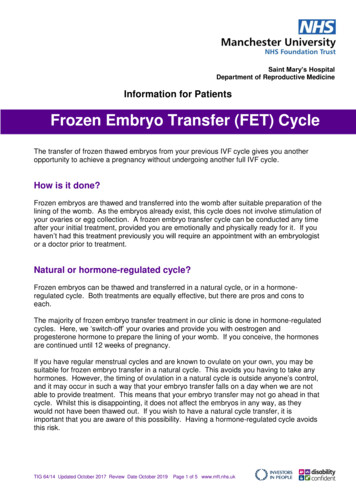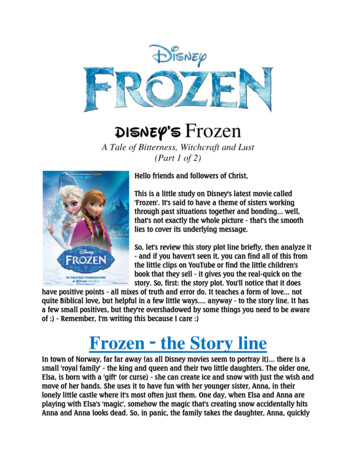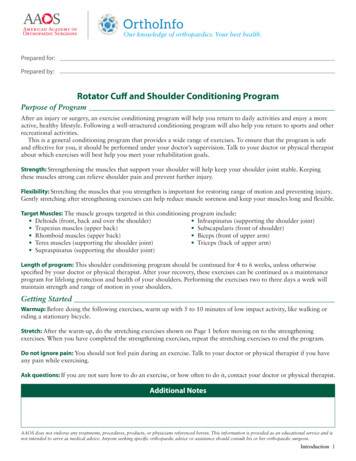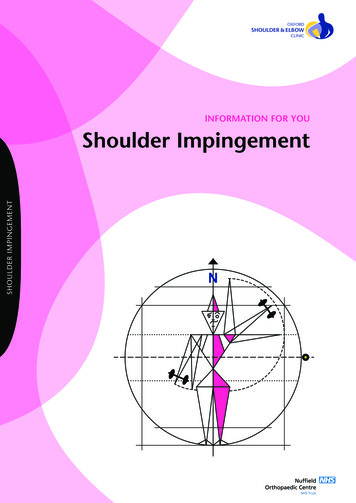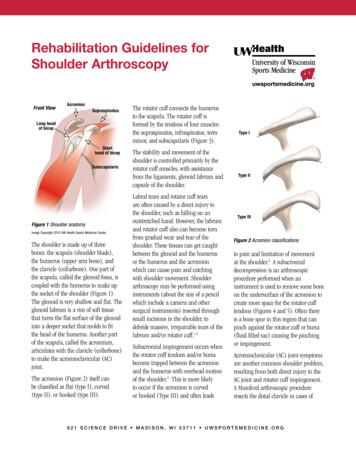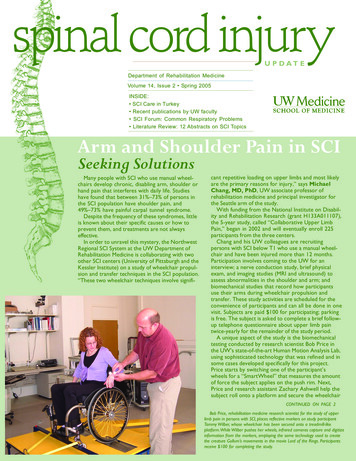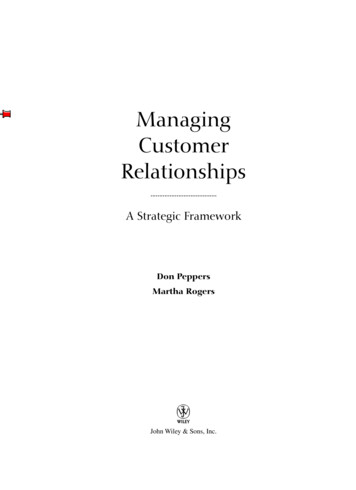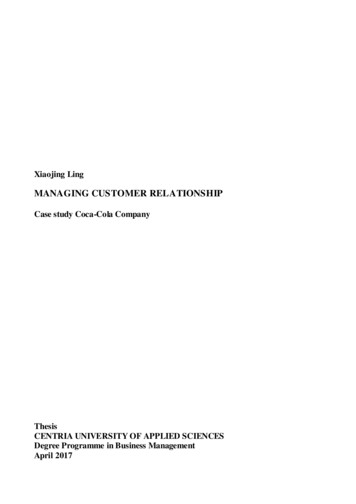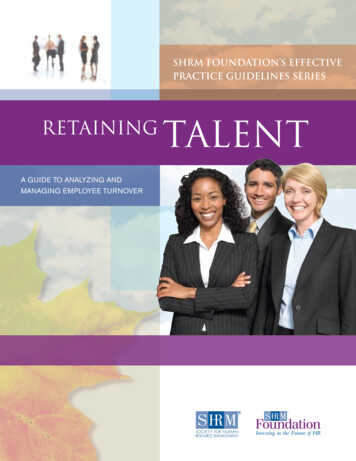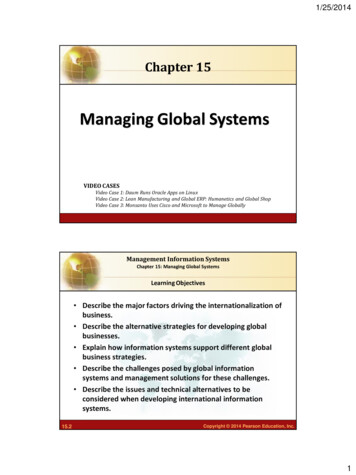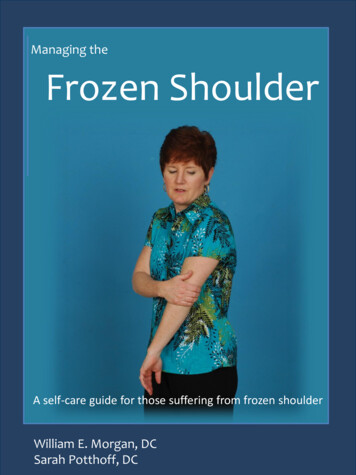
Transcription
Managing theFrozen ShoulderA self-care guide for those suffering from frozen shoulderWilliam E. Morgan, DCSarah Potthoff, DC
Managing The Frozen ShoulderSelf-care manual for those suffering from frozen shoulderWilliam E. Morgan, DCSarah Potthoff, DC
Copyright InformationThis booklet is not copyrighted. Readers are allowed to duplicate and distribute copiesas needed.
Managing the Frozen ShoulderAcknowledgements:Contributing research, proofreading and editing: Clare P. Morgan, Thomas Souza, andDan RedwoodAnatomical Artwork: Courtesy of Medical Graphics Art, Visual InformationDirectorate, Navy Medicine Support Command BethesdaPhotography: Courtesy of The Medical Photography Department, VisualInformation Directorate, Navy Medicine Support Command BethesdaDisclaimerNo book is a replacement for a competent doctor. This book is not intended to be asubstitute for the advice of your doctor, but rather a supplement to your patient-doctorrelationship. This book is not intended to provide self-diagnosis and treatment of afrozen shoulder. It is intended to help educate patients who have been diagnosed with afrozen shoulder and would like to know more about this condition. The risks of selfcare include delaying timely and appropriate professional care and possible risk ofpermanent impairment.The views expressed in this book are those of the author and do not necessarily reflectthe official policy or position of the Department of the Navy, Army, Department ofDefense, nor the U.S. Government.Nothing in the presentation implies any Federal/DOD/DON endorsement.
IntroductionFrozen shoulders are painful and frustrating. The pain associated with frozen shoulderstends to provoke those with this condition to be overprotective and limit the use of theirshoulder. This can lead to a downward spiraling of pain restricted motion pain more restricted motion more pain and so on. The downward spiral is preventedthrough understanding the condition and a purposeful attempt of maintaining motionthrough particular exercises.If motion exercises alone are not effective, other treatments should be utilized. Thisebooklet will discuss the treatment options available to patients with frozen shoulder andwill present a program of exercises intended to preserve shoulder motion.
Contents1 What is Frozen Shoulder12 Treatment Options for Frozen Shoulder83 Exercise14Appendix28
What is Frozen Shoulder?1
What is Frozen Shoulder?Frozen shoulder is the lay term for the condition known in health care as Adhesive Capsulitis.The term adhesive capsulitis implies that the shoulder joint capsule has adhesions andinflammation that limits the motion of the shoulder. While this condition is common, its causeis not well understood. We do know, however, that this condition is more common in femalesthan in males, the non-dominate shoulder is more affected than the dominate shoulder, and theprevalence is more common after the age of 40.It takes between six months and three years to stabilize and regress. Unfortunately, there isoften a residual permanent reduction in shoulder motion. This eBooklet will discuss theeffects of this condition, the management options, and will provide the reader withinformation on how to self-manage this malady.Signs and Symptoms of Frozen Shoulder: Decreased shoulder motion Reduced arm swing while walking Holding the arm in a protective manner near the body Stooped rounded shoulders Neck and back painWhat is Frozen Shoulder?2
What is Frozen Shoulder?Adhesions are fibrotic bands of scar tissue which join the surfaces of two anatomicsurfaces. With time, adhesions tend to expand in breadth while they tighten and bindnormal motion. The shoulder has a propensity for developing adhesions. If shoulderjoint inflammation and fibrotic adhesions combine, the condition we know as frozenshoulder develops.What is Frozen Shoulder?3
What is Frozen Shoulder?Due to its elastic capsule, anormal shoulder joint hasthe widest ranges ofmotion of any joint in thebody.When adhesive capsulitis(frozen shoulder) is present,Adhesionsadhesionsbetween thesurfaces of the joint capsulereduce the motion of theshoulder. The enfoldingcapsule is thought to adhereto itself in the inferiorportion of the capsule.What is Frozen Shoulder?4
Signs and Symptoms of Frozen ShoulderThere are several shoulder conditions that cause pain and reduced motion. The diagnosis offrozen shoulder should come from a provider who is well versed in differentiating variousshoulder maladies. The primary symptoms of frozen shoulder are pain and stiffness. Painmay be worse at night, and is provoked by laying on the affected shoulder.As the shoulder loses its motion, even normal activities like dressing, answering the phone,or working will become difficult.Frozen shoulders have three distinct stages of progression. Each stage typically takesmonths to progress. The normal progression of frozen shoulder through all three stages isbetween six months and two years. Without a purposeful effort to restore motion, theeffects of a frozen shoulder may become permanent.The Three stages of Frozen Shoulder ProgressionPainful StageShoulder pain is the hallmark of this stage. Itstarts gradually and progressively worsens.Frozen StagePain may reduce in this stage, althoughshoulder stiffness and restriction increase.Shoulder range of motion is dramaticallyreduced.Thawing StageWhat is Frozen Shoulder?This stage is characterized by spontaneous“thawing.” The motion will gradually increaseand the shoulder will be more responsive tostretching exercises and treatment.5
Timeline for a Frozen ShoulderFrozen StageThawing StageImmobilityPainful StageTime6-24 monthsThe three-phased progression of frozen shoulder tends to progress regardless of treatmentinterventions. In spite of an almost inevitable progression of this condition, it appears thatmaintaining motion and mobility throughout the progression of this malady reduces thepermanent loss in motion that may result from a bout with a frozen shoulder.One of the primary treatment concerns with frozen shoulder ismanaging the patient’s frustration and adjusting expectations.There will be pain and slow progression during the healing processand some patients will have lasting impairment. Healing may be along slow process fraught with periods of pain and reducedshoulder function.What is Frozen Shoulder?6
What Causes Frozen Shoulder?The mechanism of what triggers a frozen shoulder is not clearly understood. What we do know,however, are the groups who face the greatest risk of incurring this condition. Frozen shoulder ismore common in those over forty, women, and much more prevalent in diabetics and those whohave suffered from a stroke, thyroid disease, recent surgery, or Parkinson’s disease.There are two classifications:1.Primary Frozen Shoulder. This occurs without an identifiable cause.2.Secondary Frozen Shoulder. This occurs as a result of injury, surgery, or illness.Risk FactorsFrozen shoulder affects 2% of Americans. For reasons not well understood, it occurs more oftenin the non-dominant shoulder, is more prevalent in women, and occurs most often in peoplebetween the ages of 40 and 60.Other known risk factors include the following: Diabetes. Frozen shoulder affects 10% to 20% of diabetics, for unknown reasonsImmobilization of shoulderHyperparathyroidismInflammation/autoimmune reactionParkinson's diseaseWhat is Frozen Shoulder?7
Treatment Options forFrozen Shoulder8
Hierarchy of TreatmentThe most fundamental component of treating a frozen shoulder is movement. Immobility worsensthis condition. This is why shoulders are rarely immobilized as part of a treatment plan for injuryand motion is introduced early. The most common treatments for frozen shoulders are mobilityexercises and anti-inflammatory drugs. Manipulation of the shoulder is also indicated. In resistantcases, injected steroids are utilized. In rare cases, manipulation under anesthesia or surgery may beindicated. Of note, steroid injections have a similar benefit to manipulation–under-anesthesia(MUA) without the risks associated with anesthesia.This schematic shows the ascending treatment risk. The safest treatment is listed at the base ofthe pyramid with the high level of complications at the top. Patients should utilize the safesttreatment that yields results.Greatest RiskSurgeryManipulationUnderAnesthesiaSteroid InjectionsManipulation and MyofascialReleaseMobilizationMotion Restoring ExerciseLeast RiskTreatment Options for Frozen Shoulder9
TreatmentThe primary treatment for frozen shoulder isstretching. Other treatments include the use of nonsteroidal anti-inflammatory drugs (NSAIDs) likeibuprofen or aspirin, corticosteroid injections intothe affected shoulder, manipulation, mobilization,friction massage, and therapeutic modalities. Inpersistent cases, manipulation under anesthesia, orsurgery are required to restore shoulder motion.Stretching is the primary treatmentfor frozen shoulder.Treatment Options for Frozen Shoulder10
Shoulder ManipulationManual manipulation of the affected shoulder should be performed by a skilled manualpractitioner. The goal of the manipulation is to manually break free restrictive adhesions and torestore motion. Manipulation bears the risk of tearing the shoulder joint capsule or causing adisruption of internal structures.The patient can expect thepractitioner (typically achiropractor or osteopath) tomanually move the shoulder in amanner that will open the jointand place tension on theadhesions and contractures.Sometimes quick impulses areutilized to mobilize therestrictions.Chiropractic manipulation of shoulder.Treatment Options for Frozen Shoulder11
Myofascial Mobilization or “Release”Adhesions bind shoulder motion.Myofascial release is stripping massagethat attempts to break these adhesions.Myofascial/soft tissue mobilization of ashoulder.Soft tissue manipulation of the shoulder, frequently called myofascial release or soft tissuemobilization, is used to free adhesions that limit motion and create pain. Myofascial releaseis typically a slow stretching of soft tissues that is performed while applying a sustainedpressure to connective tissue of the involved structures.Treatment Options for Frozen Shoulder12
Interventional ProceduresIn the event that more conservative measures do not work, more intrusive treatments can beemployed. These interventions include steroidal injections, manipulation-under-anesthesia(MUA), and surgery. Steroid injections appear to be as effective as MUA but have less of thedangers associated with anesthesia and sedation. Surgery is usually reserved for more resistantcases of adhesive capsulitis.Shoulder Manipulation Under AnesthesiaOrthopedic manipulation of shoulder under sedation.In cases resistant to other treatment, manipulation-under-anesthesia (MUA) may be indicated.In MUA, the patient is sedated to reduce the level of pain and muscle resistance. Theorthopedic surgeon manipulates the shoulder to break free the adhesions. An intensive regimeof physical therapy is required for a couple weeks following MUA to prevent new adhesionsfrom forming following the manipulation.Contraindications for MUA include: Insulin dependent diabeticsThose at greater risk for fracture such as the elderly or those with osteoporosis.Those with bleeding disordersPatients with risks to anesthesiaSurgeryIn cases that are resistant to all other forms of treatment orthopedic surgery may be utilized toremove the restrictive adhesions.Treatment Options for Frozen Shoulder13
Exercise14
ExerciseShoulder motion is the primary treatment for frozen shoulder. It is important to continueto use the arm as much as can be tolerated while healing. If the shoulder is overly protectedfrom motion the condition will worsen.The application of a hot pack or warm shower prior to performing these exercises, and theapplication of an ice pack to the shoulder afterward will make the exercises more tolerable.While keeping the shoulder active is good at preventing the progression of this malady,moving the shoulder through all of the planes of motion is required to fully recover. Theexercise program that follows is intended to increase motion in all planes of shouldermotion.Remember that healing from a frozen shoulder will take time, in some cases a lot of time.These exercises need to be done every day, not just the days the gym or the physicaltherapist’s office is open. You will need to push yourself out of the comfort zone to obtainhealing.Exercise15
Shoulder Pendulum1.2.3.4.5.6.7.Begin using the weight of your arm without any added weights,gradually incorporating light dumbbells or kettlebells into the routineThe frozen shoulder arm follows the body’s motionKeep back straight, core (trunk muscles) tight, feet shoulder width apartSupport opposite arm to allow the affected arm to hang straight downwith full relaxation of that shoulder’s musclesUsing the motion of your body to create shoulder motion, sway yourbodyStart with small circles, gradually increasing to larger circlesPerform 20-25 circles in each directionAvoid Injury:To minimize risk of injury with this exercise, begin with no weight.Additionally, the motion of the arm should be a result of the swayingof the body, not from the muscles within the shoulder. In time, youmay add light weights (two to five pounds) such as dumbbells,kettlebells, cans of food, or water bottles.Exercise16
Shoulder Flexion (Elevation) ExerciseThis stretch is designed to improve shoulder elevation. It is performed using a small ballbeneath the hand of the affected shoulder.1.2.3.4.5.Slide the affected arm up the wall by rolling the ball in your open hand until acomfortable stretch is feltIf the affected arm is unable to actively move, assistance can be provided by theunaffected arm. Use caution and move slowlyHold up to 10 seconds and repeatWithin the limits of what you can tolerate,
shoulder maladies. The primary symptoms of frozen shoulder are pain and stiffness. Pain may be worse at night, and is provoked by laying on the affected shoulder. As the shoulder loses its motion, even normal activities like dressing, answering the phone, or working will become difficult. Frozen shoulders have three distinct stages of progression. Each stage typically takesFile Size: 2MBPage Count: 42
